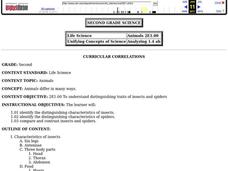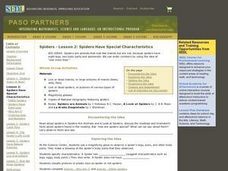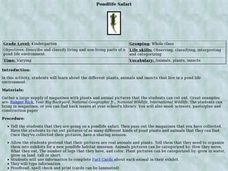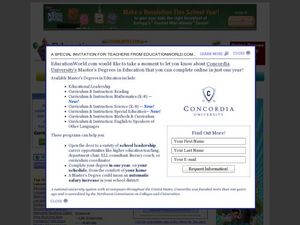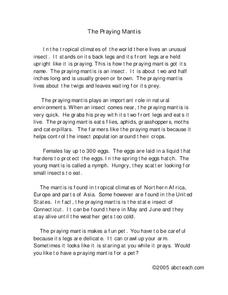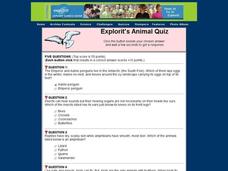Curated OER
Insects: Grasshoppers
Students examine grasshoppers as they practice following instructions. In this biology lesson plan, students identify the characteristics of grasshoppers and the functions of grasshoppers' external body parts.
Curated OER
Bugs, Bugs, Everywhere!
Pupils collect and compare bugs using magnifying lenses and graph data based on their comparisons. In this bugs lesson plan, students also make an aspirator by using a jar, tubing, and screen.
Curated OER
Animals
Second graders explore the ways in which animals differ. They discuss the characteristics of insects and spiders. Students identify the characteristics of insects and spiders. They compare and contrast insects and spiders.
Curated OER
Curious About Creepy Crawlies?
Students create oral presentations and visual aids to assist their inquiry about various insects. They reflect on the importance of learning about insects while working in small groups.
Curated OER
Meadows Observations
Students investigate and examine the different living things they find in a meadow. Students record the different colors that are present and create a graph, identify and label parts of a plant, use a magnifying lens to examine all ...
Curated OER
Spiders Have Special Characteristics
Students state reasons why spiders are grouped in specific categories, including what distinguishes a spider from an insect. They report on their observations of the spiders. They illustrate their report with drawings in their journals.
Curated OER
Arthropod Coloring Worksheet
In this biology worksheet, learners color and label the different parts of arthropods. They complete 63 short answer and fill in the blank questions on arthropods.
Curated OER
Dissecting Crickets
Learners dissect a cricket and note the three body regions, wings, and legs. They observe the yellow malphigian tubes and remove them. They dissect the esophagus and analyze the heart for respiratory rates and heart beat rates.
Curated OER
What Kind of Animal Are You?
With the descriptions of six different animal groups (amphibians, birds, fish, insects, mammals, reptiles), students match different examples of animals to their proper groups (lizard to reptiles, girl to mammals, etc). The activity...
Curated OER
Cricket Wars
Students investigate crickets in their habitat. In this insect lesson, students create a cricket habitat by using a glass jar with grass clippings and cloth. Students observe how crickets interact with each other and their eating habits.
Curated OER
Pond-life Safari
Students determine the living and non-living parts of pond life. In this pond life lesson plan, students examine the plants, animals, and insects that live in ponds. They look through a variety of print media, cut out pictures, and...
Curated OER
Bugs
Students explore the wonders of bugs. In this bug lesson, students examine various types of bugs. Students make crafts, sing songs, discuss nutrition, and investigate different types of insects.
Curated OER
The Honey Bee Body - Paper Honey Bee
Young scholars construct a paper honey bee to learn the six major parts of a bee and other insects. They compare their own body parts to those of bees. They utilize worksheets imbedded in this plan to help them design their bee.
August House
Anansi And Turtle Go To Dinner
That tricky Anansi! Join him and Turtle in the story Anansi and Turtle Go to Dinner by Bobby and Sherry Norfolk, based on the African folktale. Kids answer comprehension questions and sing songs about spiders before creating spider...
Curated OER
Arthropod Rhymes
In this arthropods worksheet, students read rhymes about arthropods and use the science terms they have learned to answer the question following the rhyme. This worksheet has 12 fill in the blank questions.
Curated OER
Spiders Build Giant Web in Texas Park
Learners make predictions about a photograph of a humongous spider web, then read a news article about thousands of spiders that worked together to build it. In this biology and current events lesson, the teacher introduces the article...
Curated OER
All About Ants
Students create model ants in order to study the characteristics of insects such as body segments, number of legs, and feelers, as well as how these characteristics serve the insect.
Curated OER
The Praying Mantis
In this praying mantis reading comprehension worksheet, students read a 5 paragraph non-fiction selection about the insect and test their reading comprehension as they answer 7 multiple choice questions based on the reading.
Curated OER
Bug Hunt
Students examine the different characteristics of bugs in their local area. They take characteristics of bugs they have observed and create their own new insect. They draw their new bug and share it with the class.
Curated OER
Spider Anatomy Lesson: Is It a Spider?
Students review information on a website which shows different types of spiders. They sort images of spiders from other insects. They create their own spider out of materials and share them with their classmates.
Curated OER
The Spider Beside Her
Second graders expand their knowledge of spiders. By creating a model of a spider, 2nd graders recognize differences between spiders and insects and determine that a spider is not an insect.
Curated OER
Related Number Pairs
Third graders use tables to organize and display related pairs of numbers, such as the relationship of the number of insects to the total number of legs. They generate a table of related number pairs based on a real-life situation,...
Curated OER
Explorit's Animal Quiz
In this animals worksheet, students complete a five question multiple choice on-line interactive quiz about animals. This quiz has questions about mammals, insects and birds.
Curated OER
Children's Health
Students learn the basic parts of an insect, where they like to hide indoors, and how to safely get rid of them. They assemble the cockroach body and cut it out of a brown bag. They attach pipe cleaners as legs and attennae. They then...


